Dayton is a midsize town in Ohio that few Americans would have occasion to visit or even find on a map. Apart from the Aviation Heritage Trail that includes the bike shop of the world’s first pilots, Orville and Wilbur Wright, there is not a great deal to see.
But for the people of Bosnia and Herzegovina, Dayton is the most famous place in the US, overshadowing New York, Washington or Los Angeles. Its name has come to encapsulate Bosnia’s purgatory: life in the absence of war, but never quite at peace. And a long way from happiness or normality.
It is 20 years since agreement was reached in Dayton to end the conflict that cost some 100,000 lives. As in Ukraine today, what appeared on the surface as a civil war was, in reality, driven principally by the ambitions of a more powerful neighbour. The dismemberment of Bosnia in 1992 was orchestrated from Belgrade by President Slobodan Milošević, seeking to carve out a “Greater Serbia” as the old communist Yugoslavia fell apart. He worked through Bosnian Serb proxies, fighting against a shaky alliance of Muslims (known as Bosniaks) and Croats. To add to the agony, the Croats temporarily turned on their Bosniaks in 1993, at the behest of Franjo Tudjman, the strongman in neighbouring Croatia.
The General Framework Agreement for Peace in Bosnia and Herzegovina, reached in Dayton on 21 November 1995 (and formally signed in Paris a few weeks later), was not just supposed to stop the killing. It was meant to heal the wounds of ethnic division. Yet, two decades on, the country remains as rigidly divided as ever, between a Serb half, the Republika Srpska, and a Federation of Bosniaks and Croats.
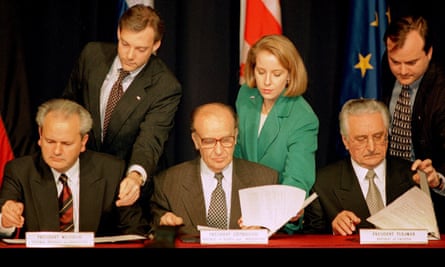
Officially, they are all citizens of the same nation, but Serb leaders seek to undermine its legitimacy at every turn, constantly pushing for partition. The Croats, too, are ambivalent at best.
It is hardly surprising that such a fundamental disagreement about the nature of the state has a paralysing effect on governance. For the past decade, the country has drifted. Bosnia currently has one of the highest youth unemployment rates in the world, according to World Bank statistics. The anger and despair fuels yet more nationalism, in part because the system is rigged that way. It is a self-sustaining machine for producing misery.
Up to now, that misery has been contained, out of sight from the rest of Europe, but not for much longer. With each passing week, the prognosis for Balkan stability grows more alarming. There are even murmurs of a possible return to conflict. They seem far-fetched for now, but their persistence reflects the depth of anxiety about the future.
Angela Merkel raised the spectre of a new war last month, concerned that an influx of new refugees from Syria, Iraq and elsewhere could demolish a Balkan settlement held together thus far by improvisation, war-weariness and wishful thinking.
Milorad Dodik, the demagogic leader of the Bosnian Serbs, has called a referendum for 15 November aimed at landing an axe blow to the country’s unity, rejecting the authority of international institutions that are supposed to be caretakers of that unity. Vladimir Putin is nourishing Dodik’s ambitions with promises of financial support. Meanwhile, Islamic State is aggressively trawling for recruits among disaffected Bosniak youth.
Dayton is one of the most frequently used words on the evening news. It is a noun, a verb, an adjective – a synonym for inertia, neglect and despair.
One of the biggest questions in Bosnian politics is how to unlock the 20-year-old handcuffs – whether Dayton can be killed. Its promise of salvation now appears to have concealed the seeds of the country’s potential destruction. So is Dayton a model or a cautionary tale? The answer has implications for future efforts to resolve any number of complex and bitter conflicts around the world.
Creating ‘intensity of purpose’
Dayton is the home of the Wright-Patterson air force base, which had been used by US test pilots and the first Mercury programme astronauts in the 50s. It was the home of the Right Stuff, though by the time of the Bosnian war, those glories had already faded into the distant past. The US State Department chose Wright-Patterson because it was a good distance from any major American metropolis. Milošević and Tudjman, their semi-obedient proxies from inside Bosnia, as well as Bosnia’s Muslim president, Alija Izetbegović, could all be sequestered there until they made peace.
The US special Balkan envoy, the remarkable diplomat Richard Holbrooke, was fascinated by the story of Camp David, where Israel and Egypt made their historic peace deal in 1979 under the gaze of President Jimmy Carter. Just before leaving for Dayton, Holbrooke phoned Carter and quizzed him about the secrets of Camp David’s success. The lessons Holbrooke came away with underlined the importance of isolating the negotiators, particularly from reporters. Shared sequestration in a remote site would remove distractions and the temptations of leaks to the press. It was supposed to break down personal barriers and create “intensity of purpose”.
Wright-Patterson was supposed to have an added advantage. Compared to the well-appointed presidential cabins at Camp David, it was a spartan place with bland, military-style food. It was hoped a certain degree of discomfort would spur the leaders into making concessions so they could return to their homes.
For their three weeks in Dayton, the negotiators lived by Holbrooke’s rules. He dictated who attended which meetings, what was fed to the press and what was reported back to Washington. Many of the seasoned and senior diplomats at the talks chafed under his tutelage, particularly the Europeans. The British, French, Germans and Russians, who made up the remainder of the Contact Group for the negotiations, were aware they were there chiefly to make up the numbers and eventually to commit resources to the implementation of a peace agreement. They were excluded from almost all the critical negotiating sessions. In its internal history of the deal, the State Department revealed that Holbrooke’s team felt “the Europeans had done more to sabotage the talks than help”. They were further humiliated by being subjected to full security searches as they moved around the base, while their Americans and Balkan counterparts were allowed to pass unhindered. The head of the French delegation, Jacques Blot, drew the line at sniffer dogs. “For the dignity of France,” he reportedly declared, “I will not be sniffed.”
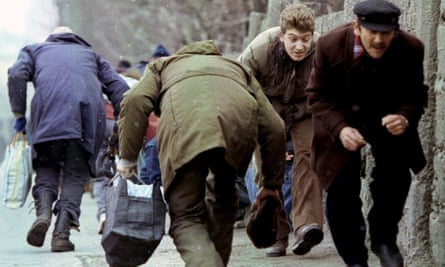
Enforced proximity may not have instilled goodwill among the rival leaders of the former Yugoslavia, but it did make it more difficult for them to avoid each other. At one point, Milošević and the Bosnian prime minister, Haris Silajdžić, found themselves eating at nearby tables at the Wright-Patterson officers’ mess. Spotting an opportunity, Holbrooke started shuttling between them and the two leaders ended up sitting together, for the first time since the war began, drawing maps on napkins.
A deal splitting the country almost exactly in half – 51% for the Federation, 49% for the Republika Srpska – was reached only after the 19 November deadline was passed. Milošević gave some eleventh-hour concessions, allowing Sarajevo to stay under Federation control and agreeing that a strategic town on the northern border, Brčko, should be neutral, under international administration. He agreed to a land corridor between Sarajevo and the eastern enclave of Goražde over a late-night bottle of whisky.
By the end, the Americans ended up viewing Izetbegović’s Bosnian delegation as the recalcitrant party. The elderly president dithered over Milošević’s offers, and it was principally the US threat to walk away from the talks and hand their stewardship over to the Europeans that scared him into acceptance.
Muhamed Sacirbey, Bosnia’s foreign minister who resigned in the midst of the Dayton talks in protest at the pressure being applied on the Bosniaks, argues that Milošević simply out-gamed his fellow leaders. “He was the chatty guy around the poker table, and when he chatted you up he understood what your position was but you didn’t get to know what his bottom line was,” Sacirbey says. “He understood that Holbrooke was very eager to get a deal, and much of this eagerness was very personal, for recognition and further political ambition … In the end, I realised that much of what happened in Dayton was about the personalities.”
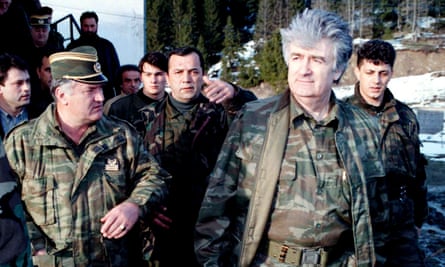
A moral and historical vacuum
Izetbegović was in a bind. The 51-49% split had been agreed at talks in Geneva the previous year, and the US secretary of state, Warren Christopher, wanted to stick to it. By holding out over details, the Bosnian leader was told, he would be prolonging the killing of his own people. Moreover, the near-equal division of Bosnia between the two principal parties, reasonably close to the ceasefire lines agreed in October, had the ring of fairness about it.
It seemed fair however only in a moral and historical vacuum. The halving of Bosnia had been created by “ethnic cleansing” through mass killings and deportation, a policy carried out by the Bosnian Serb leader, Radovan Karadžić, with his military commander, Ratko Mladić, and orchestrated from Belgrade by Milošević himself, the saviour of Dayton. All three would eventually be indicted by the Hague war crimes tribunal for genocide. Milošević died during his trial, Karadžić is awaiting a verdict and Mladić is currently presenting his defence.
They hacked Republika Srpska out of Bosnia through repeated atrocities such as the concentration camps established in 1992 around the western town of Prijedor, where more than 3,000 people were killed, and the slaughter of 8,000 men and boys from the Muslim enclave of Srebrenica in July 1995, just four months before Dayton.
The territorial gains made through such methods were carved in stone at Dayton, while Republika Srpska was given international recognition. The deal imposed no direct obligation on the Nato-led peacekeepers to arrest war criminals. That only came later.
The constitution established under Dayton also froze in place the ethnic politics that had fuelled the war. To this day, places at all levels of government are allocated according to affiliation to the three principal groups: Bosniak, Serb or Croat. If you are identified in any other way – Jewish, Roma, or “other”, just Bosnian with no specific ethnic label – political leadership in Bosnia and Herzegovina is out of your reach, by law.
In 2009, two Bosnian citizens of Roma and of Jewish origin challenged the Dayton constitution at the European court of human rights and won. The Strasbourg court ordered Bosnia to amend it to allow “others” to run for high office. That has still not been done. The one thing the nationalists of all stripes can agree on is this barrier to political entry.
That is unsurprising. Dayton spawned a political system that is a cash cow for politicians. It is among the most complex in the world, with a tripartite presidency and full cabinets and parliaments at the state level, as well as in the two entities. The Federation is divided, in turn, into 10 cantons, each with its own government. The top-heavy political elite that fills this profusion of posts makes six times the average Bosnian wage, plus a wide array of perks. Relatively speaking, the country’s politicians are among the richest in Europe. Dayton created a system that is both self-serving and self-perpetuating.

There was a clear, albeit risky, alternative to all this. By the autumn of 1995, the tables had finally been turned in the Bosnian war. Nato was bombing Serb positions after the latest massacre in Sarajevo, and the Croatian army was advancing from the west in coordination with the Bosnian army and Bosnian Croat militias. If that offensive had continued, the Serbs’ only significant town, Banja Luka, would have fallen, as would have Karadžić’s regime. The defeat, combined with the fresh influx of Serb refugees from Bosnia, would have weakened Milošević’s hold on power in Belgrade. If he had been ousted then, the 1999 war in Kosovo, his last desperate throw of the dice, could have been avoided.
However, the advance was halted on the request of the Clinton administration before it reached Banja Luka, and Bosnia’s fate was sent off on its current trajectory instead.
Bathroom diplomacy
“Thanks to Dayton, Karadžić’s Serbs snatched a victory from the jaws of defeat, the Republika Srpska was consolidated and Bosnia was condemned to permanent dysfunction,” says Marko Attila Hoare, a British historian and author of several books on Bosnia. “So it would have been much better for Bosnia if Dayton hadn’t happened.”
Arguably the pivotal episode between war and peace took place in mid-September 1995, in a Zagreb toilet. Holbrooke had come to the Croatian capital with orders from Washington to tell Tudjman to stop the offensive, but he did not feel bound by them. Conditions on the ground were evolving rapidly and he considered himself free to improvise. He had still not decided what to do by the time he reached Tudjman’s palace, so he ducked into the presidential bathroom with the US ambassador to Croatia, Peter Galbraith. Tudjman was famous for bugging conversation, but they hoped the sound of running water might provide some cover for the conversation.
“Banja Luka was really a tough call for both of us,” Galbraith recalls. “You could have had 300,000 or 400,000 people trying to flee and it would have been a huge humanitarian disaster. And then there was the question of Tudjman’s behaviour. You have got to wonder what would have happened if he had gotten hold of Banja Luka.”
The Croatian leader had long harboured ambitions for a “Greater Croatia” (a mirror of Milošević’s “Greater Serbia”) that would encompass Banja Luka. But the killing of civilians after Tudjman’s offensive the previous month to wrest control of Serb enclaves inside Croatia raised fears that worse might yet be to come. “If the Croatians had behaved better after Operation Storm, you might have had a very different outcome in Bosnia,” Galbraith says.
Others attribute the decision to call an abrupt halt to the war to political expediency in Washington. Daniel Serwer, who was at Dayton as the US envoy to the Federation, says the Clinton administration wanted to resolve the situation quickly before embarking on a re-election campaign against Robert Dole, who was heavily critical of the administration’s handling of the conflict. “To end the war when we did was determined by American requirements over timing more than Bosnian requirements,” Serwer says. Yet it did stop the killing, and kept it at bay for the past two decades at least, longer than Serwer and many of his colleagues expected. “We thought it was just a house of cards about to come tumbling down,” he says.

Ultimately, the choice between allowing the war to continue in the hope of a more just outcome or cutting it short to save an untold number of lives is an impossible dilemma. There are too many unknowns, including the rate of exchange between the immediate human price and long-term stability and recovery. Holbrooke and Clinton made their choice and have been both lauded and reviled for it.
In theory, changing the Dayton settlement now should be easier. Almost everyone agrees it should be done. Goaded into action by fear of new inter-ethnic conflict or a festering and failed Muslim rump state in the heart of southern Europe, western European governments are seeking to unpick Dayton’s legacy. The British and Germans have launched a reform initiative based on incremental steps. There are many sceptics however, including some of those who were at the Wright-Patterson base two decades ago. They believe that Bosnia can only move on from its wartime legacy once a stake is put through Dayton’s heart once and for all. But no one currently has sufficient power or resolve to perform the deed.
“They glom on to this reform proposal which they hope will dilute the hold of the ethnic nationalists on power,” Serwer says. “I wish them the best, but I don’t think they have anything near the horsepower required to really do it.”
The one lesson that most of the surviving cast from Dayton can agree on is that it was a mistake at such a momentous juncture in history to treat peace and justice as substitutes. “It ended most of the killing. I don’t think the killing’s going to come back, but you can never be sure … But except for the ending of the war, the promise of Dayton has proven to be illusionary,” Sacirbey says. “I think it was, at best, a lost opportunity; at worst, it was just a ceasefire.”
But a ceasefire is no small thing in a war that was killing tens of thousands of civilians. For many Bosnians, not matter how black things get, Dayton will always be better than nothing for that reason. For Reuf Bajrović, the former Bosnian energy minister, the agreement is the worst deal possible, apart from all these likely alternatives.
“It was a diplomatic and political butchery where there was not much foresight about the consequences. It was about stopping the war before the 1996 presidential elction in the US,” he says. “However, it was by far the best option available at that particular moment in history. Without the US involvement, Bosnia would have looked much more like Syria of today because the Serbs – like Assad now – would have no incentive to negotiate. Hence, it was a belated intervention, and it rewarded the genocidal policies of the Karadžić Serbs, but with hindsight it did more good than bad.”
Julian Borger’s book, The Butcher’s Trail: How the search for Balkan War Criminals became the World’s Most Succesful Manhunt will be published on 19 January by Other Press.
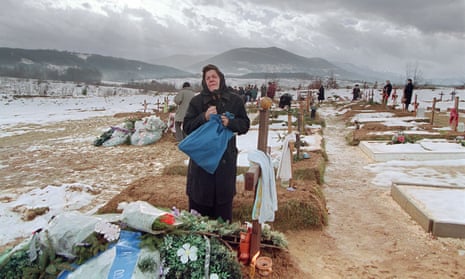
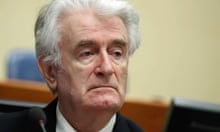





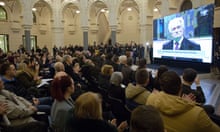


Comments (…)
Sign in or create your Guardian account to join the discussion